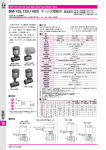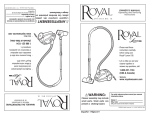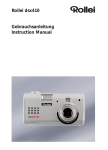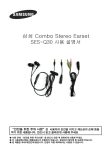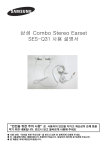Download Dynaudio BM14S Owner`s manual
Transcript
BM14S II – Owner’s manual Introduction Introduction Important safety instructions The lightning flash with an arrowhead symbol within an equilateral triangle, is intended to alert the user to the presence of uninsulated “dangerous voltage” within the product’s enclosure that may be of sufficient magnitude to constitute a risk of electric shock to persons. The exclamation point within an equilateral triangle is intended to alert the user to the presence of important operating and maintenance (servicing) instructions in the literature accompanying the product. 1.Read these instructions. 2.Keep these instructions. 3.Heed all warnings. 4.Follow all instructions. 5.Do not use this apparatus near water. 6.Clean only with dry cloth. 7.Do not block any ventilation openings. Install in accordance with the manufacturer’s instructions. 8.Do not install near any heat sources such as radiators, heat registers, stoves, or other apparatus (including amplifiers) that produce heat. 9.Do not defeat the safety purpose of the polarized or grounding-type plug. A polarized plug has two blades with one wider than the other. A grounding type plug has two blades and a third grounding prong. The wide blade or the third prong are provided for your safety. If the provided plug does not fit into your outlet, consult an electrician for replacement of the obsolete outlet. 10.Protect the power cord from being walked on or pinched particularly at plugs, convenience receptacles, and the point where they exit from the apparatus. 11.Only use attachments/accessories specified by the manufacturer. 12.Use only with the cart, stand, tripod, bracket, or table specified by the manufacturer, or sold with the apparatus. When a cart is used use caution when moving the cart/apparatus combination to avoid injury from tipover. 13.Unplug this apparatus during lightning storms or when unused for long periods of time. 14.Refer all servicing to qualified service personnel. Servicing is required when the apparatus has been damaged in any way, such as power-supply cord or plug is damaged, liquid has been spilled or objects have fallen into the apparatus, the apparatus has been exposed to rain or moisture, does not operate normally, or has been dropped. 15.WARNING: To reduce the risk of fire or electric shock, this apparatus should not be exposed to rain or moisture and objects filled with liquids, such as vases, should not be placed on this apparatus. 16.To completely disconnect this equipment from the mains, disconnect the power supply cord plug from the receptacle. 17.The mains plug of the power supply cord shall remain readily operable. 18.Danger: To reduce the risk of electric shock, do not remove the back panel and do not expose the apparatus to rain or moisture. No user serviceable parts inside. Refer servicing to qualified personnel. About this operating manual Signal words Caution – Indicates a potentially hazardous situation which, if not avoided, could result in damage to equipment. CAUTION – Indicates in combination with a safety sign a potentially hazardous situation which, if not avoided, could result in minor or moderate injury or damage to equipment. WARNING – Indicates in combination with a safety sign a potentially hazardous situation which, if not avoided, could result in death or serious injury. DANGER – Indicates in combination with a safety sign a hazardous situation which, if not avoided, will result in death or serious injury. Owner’s manual1 Introduction 2 BM14S II Introduction About this manual This manual is divided in three main chapters, in which you can find all the information needed to operate the BM14S II successfully: –Before operation: Learn all about unpacking and connecting the subwoofer. The controls and connections on the back panel are also described here. –Operation: In this chapter you will learn how to operate the subwoofer in general and how to position it properly for optimum performance. –Optimizing settings/Troubleshooting: Here detailed explanations can be found on how to optimize the settings in order to achieve the maximum sound quality. Owner’s manual3 Before operation 4. Getting started Before operation Unpacking the subwoofer 1 2 3 Getting started Check that the contents are complete: –Subwoofer: The factory-set power requirements (refer Unpacking the subwoofer to label on rear of subwoofer) should correspond to the region where the subwoofer was purchased. You should 1. Unpack the subwoofer on a clean, even and soft area; floor carpeting is very suitable. also refer to the “Important safety instructions” on page 1. 2. The packaging should be opened from the top (1). Remove all accessories that – Front grille. come packed with the subwoofer (such as AC power cordbaffle and grille). Do not remove the top part of the protective material. – AC mains lead. The supplied lead should be suitable for 3. With the protective material still in place but with accessories removed, carefully tilt the packaging on its side (1) and tilt again to the turn itregion upside-down (2). Ensure where the subwoofer was purchased. that no part of the top-cover is obstructing the opening at the top. from –This owner’s manual. 4. The outer packaging can now be lifted away the subwoofer itself (3). Remove the protective material that now is on top. 5. Open the bag and remove such from around the base of the subwoofer. Grille 6. Again, carefully tilt the subwoofer on its side and again to turn it onto its feet. Note that the top part of the protective material will now come off easily so ensure The subwoofer can be operated that the subwoofer doesn’t drop or slide away in the process. without the grille. However, it is recommended that the grille is mounted during normal use Check that the contents are complete: to help damage or dirt settling on the cone • Subwoofer: The factory-set power requirements (referprevent to label onaccidental rear of subwoofer) should correspond for the region where the subwoofer was of the loudspeaker. With subwoofers, the influence of the grille purchased. Refer also to chapter “Important Safety Instructions” on page 3. • Front baffle grille. on the sound is virtually negligible. • AC mains lead. The supplied lead should be suitable for the region where the subwoofer was purchased. • Owners Manual. To remove the grille: –Gently pull the grille at all corners. Grille even and soft area; 1.Unpack the subwoofer on a clean, To fit the grille: floor carpeting is very suitable. The subwoofer can be operated without the grille. However, it is recommended that the grillefrom is mounted normal use to helpprevent accidental dirt the corresponding front baffle holes. –Line up thedamage studsorwith 2.The packaging should be opened the during top (1). Resettling on the cone of the loudspeaker. With subwoofers, the influence of the grille on Gently push the grille in at all corners. move all accessories that come packed with the subwoofthe sound is virtually negligible. er (such as AC power cord andTogrille). Do not remove the remove the grille: Note: top part of the protective material.Gently pull the grille at all corners. Be careful when mounting the grille not to touch the cone of 3.With the protective material still in place but with accesTo fit the grille: Line up the studs corresponding front holes. thebaffle loudspeaker itself. sories removed, carefully tilt the packaging onwith itsthe side (1) Gently push the grille in at all corners. and tilt again to turn it upside-down (2). Ensure that no part Note: Be careful when mounting the grille not to touch the cone of the loudspeaker of the top-cover is obstructing the opening at the top. itself. 4.The outer packaging can now be lifted away from the subwoofer itself (3). Remove the protective material that now 4 Dynaudio Acoustics BM14S is on top. 5.Open the bag and remove such from around the base of the subwoofer. 6.Again, carefully tilt the subwoofer on its side and again to turn it onto its feet. Note that the top part of the protective material will now come off easily so ensure that the subwoofer doesn’t drop or slide away in the process. 4 BM14S II 4. Getting started Before operation Controls and connections (1) AC IN Controls and connections Mains power input. 1 2 11 AC IN 2 Main power switch (to switch the subwoofer manually on and POWER ON (Main) (2) POWER ON (Main) Mains power input. off). LED shows Main power switch (to switch theoperation subwoofermode: manually on and off). –red:mode: subwoofer switched on and in mute mode LED shows operation • red: subwoofer switched on and inismute mode –green: subwoofer activated • green: subwoofer is activated 3 Power (Mode)(3) Power (Mode) • On: subwoofer is permanently –On: subwoofer on is permanently on • Auto: subwoofer switches on when signal is –Auto: subwoofer switches ondetected when signal is detected 4 Gain 3 5 Subwoofer volume level. volume level. Subwoofer Lowpass 4 6 (4) Gain Subwoofer lowpass frequency: continuously variable from 50 to 150 Hz. (5) Lowpass Phase Subwoofer lowpass frequency: continuously variable from 50 Phase setting:tophase can be set to 0° or 180°. 150 Hz. 5 10 1 6 7 Mode Subwoofer operation mode LFE or Slave: (6) Phase • LFE: setting for normal usephase and Master use Phase setting: can be set to 0° or 180°. • Slave: setting for second and all following subwoofers 8 Highpass (7) Mode Allows cutting Subwoofer off low frequencies of the signalLFE provided at the SAT/SUB output: operation mode or Slave: • Flat: signal is not processed –LFE: setting for normal use and Master use • 60: cut-off frequency at 60 Hz –Slave: setting for second and all following subwoofers • 80: cut-off frequency at 80 Hz 7 9 9 SAT/SUB (output) (8) Highpass Output for satellite system to be connected. This signal is processed according to the HighpassAllows setting.cutting off low frequencies of the signal provided at the SAT/SUB output: 10 SAT/SUB (input) 10 9 –Flat: signal notsignal processed Input for full bandwidth signal. is This will be processed according to the Highpass setting andcutoff provided at the SAT/SUB –60: frequency at 60 Hzoutput. 8 –80: cutoff frequency at 80 Hz 11 LFE • LFE/Slave: input for LFE signal • Slave: output to next subwoofer (9) SAT/SUB (output)if installed Terminal pinout (sockets 9, satellite 10 and 11) Output for system to be connected. This signal is pro1=0 Dynaudio Acoustics BM14S 2=+ 3 = – according to the Highpass setting. cessed 5 Owner’s manual5 Before operation (10) SAT/SUB (input) Input for full bandwidth signal. This signal will be processed according to the Highpass setting and provided at the SAT/ SUB output. (11) LFE 4. Getting started –LFE/Slave: input for LFE signal –Slave: output to next subwoofer if installed Connecting the Terminal pinout (sockets 9, 10 and 11) 1 = 0 2 = + 3 = – CAUTION CAUTION Damage due to improper connections! Improper connections may damage the device. –Set the mains power switch to OFF before connecting the BM14S II. –Only switch the subwoofer on (mains power switch to ON) after all connections and set up steps have been properly subwoofer completed. Subwoofer inputs The BM14S II provides two different signal inputs: Damage due to improper connections! Improper connections may damage the device. LFE/Slave Set the mains power switch to OFF before connecting the BM14S. Thison input allows LFE (Low Frequency Effect) Only switch the subwoofer (mains powerthe switch to ON) after all connections and set up steps havebe been properly completed. connected. The signal is: Connecting the subwoofer LFE/Slave SAT/SUB Subwoofer inputs channel to –reproduced by the subwoofer –routed to the Slave output for a second subwoofer to be connected. The Lowpass control has no impact on this input. The BM14S provides two different signal inputs: SAT/SUB + LFE/Slave Lowpass Mode Highpass + Gain Phase + Slave 6 This input allows the connection of a full bandwidth signal. The Frequency signal is: Effect) channel to be connected. This input allows the LFE (Low The signal is: –reproduced by the subwoofer, • reproduced by the subwoofer –routed to the SAT/SUB output terminals. • routed to the Slave output for a second subwoofer to be connected. Low frequencies are cut-off according to the Highpass setting, The Lowpass control has no impact on this input. –routed to the Slave output for a second subwoofer to be SAT/SUB connected. High frequencies are cut-off according to the This input allows the connection of a full bandwidth Lowpass setting. signal. The signal is: • reproduced by the subwoofer, • routed to the SAT/SUB output terminals. Low frequencies are cut-off according to the Highpass setting, • routed to the Slave output for a second subwoofer to be connected. High frequencies are cut-off according to the Lowpass setting. SAT/SUB BM14S II Connecting a single subwoofer Connecting a single subwoofer 1 LFE Before operation Multiple subwoofer connections Connecting as LFE channel (1) LFE X Connect subwoofer to LFE/SlaveSub... input. (Slave) Multip The BM Using m acoustic When u followin Connecting as subwoofer for satellites (2) To conn 2 X Connect full bandwidth signal to SAT/SUB inpu 1. Con Stereo Sub reproduces sum of right and left signal. 2. Set X Set the Mode switch to LFE. 3. From Stereo Note: Connecting as LFE channel (1) –Connect subwoofer to LFE/Slave input. Connecting as subwoofer for satellites (2) –Connect full bandwidth signal to SAT/SUB input. Sub reproduces sum of right and left signal. –Set the Mode switch to LFE. LFE Notes: –You can also use both connection types. The Sub... signals will (Slave) be combined in the BM14S II and routed accordingly. This allows the BM14S II to reproduce both the LFE channel information as well as the bass range of the connected satellite system. –Use Slave mode if you want to use an external bass management system. LFE 4. Set • You can also use both connection types X This Furt the BM14S and routed accordingly. all fo both the LFE channel information as we Sub 1 Subsystem. 2 connected satellite Note: (Master) (Slave) • Use Slave mode if you want to use an e system. The BM14S II can be used stand-alone or together with multiple subwoofer units. Using multiple units may be helpful if the listening room is quite large or has difficult acoustic conditions. When using two or more subwoofers, the first one (designated “Master”) controls the following subs (designated “Slave”) via a subwoofer cable. Multiple subwoofer connections To connect multiple subwoofers: The BM14S be used stand-alone 1.Connect the can first subwoofer as described before. or together w 2.Set Mode switch of first subwoofer to LFE. Using multiple Acoustics units may be helpful if the listening ro Dynaudio BM14S 3.From the Slave output of the first subwoofer connect a acoustic conditions. XLR cable to the LFE/Slave input of the following subWhen using two or more subwoofers, the first one (d woofer. This one now becomes the slave. following subsswitch (designated via a subwoofe 4.Set the Mode of the second“Slave”) subwoofer to Slave. subwoofers can be connected in the same way. Set ToFurther connect multiple subwoofers: the Mode switch of all following subwoofers to Slave respec- 1.tively. Connect the first subwoofer as described before Stereo 2. Set Mode switch of first subwoofer to LFE. 3. From the Slave output of the first subwoofer con LFE/Slave input of the following subwoofer. Thi Owner’s manual7 4. Set the Mode switch of the second subwoofer to 5. Operation Before operation Connecting loudspeakers Notes: –When using multiple subwoofers in a Master-Slave setup, it is recommended that the subwoofers are all the same model. –If you wish to use multiple subwoofers with full individual control, set the Input switch for all to the LFE position. From the source subwoofer output, use a Y-connector. Connectin If your source in LFE or SLA double proces LFE To connect lo 1. Connect th 2. From the s power amp Stereo Note: The si conne multip To power amplifier or active speakers Opera If your source provides bass management, you can use the BM14S II’s LFE input alone in LFE or SLAVE mode, depending on the management system capabilities. Avoid double processing if possible. Switchin 1. To connect loudspeakers 1.Connect the subwoofer (see “Connecting a single sub- you have Once woofer” on page 8). subwoofer and 2.From the subwoofer SAT/SUB output connect a XLR 1.cable Connect th to the inputs of the power amplifier you use for your speak2. 2. Switch the ers. The status Note: 3. Select a po The signals connected to the inputs are provided at the Slave output for connecting another subwoofer. See page 8 to learn Power modes 3. more about connecting multiple subwoofers. 8 • On: the su • Auto BM14S II – When a automat Operation or active speakers Operation Operation mode automatically. The status LED on the back of the subwoofer will light up red. A Switching the subwoofer on Switching the subwoofer on Note: 1. 2. 3. Once you havethe ensured yourself that all have To switch subwoofer completely off,necessary set the mainconnections POWER subwoofer and the connected components can be switched on. switch to the OFF position. H 1. Connect the subwoofer to the mains power. H Adjusting the volumeon (Gain) 2. Switch the subwoofer with the main POWER switch on the re The status LED on the rear of the subwoofer will light up red. 3. Select CAUTION a power mode with the Power switch on the rear panel. High Sound Levels! High sound levels can cause auditory defects. To avoid audiPower modes tory defects, do not listen to high sound levels over a longer • On: the subwoofer is switched on permanently period of time. Th • Auto sp – When a music signal is detected, the internal amplifier is activ automatically. The status LED on the back of the subwoofer To wi As long as a music signal is available on the subwoofer’s inpu switched on. Once you have ensured yourself that all necessary connec– After 15 to 20 minutes of not sensing any input music signal, th tions have been made, the subwoofer and the connected switch itself to Standby mode automatically. The status LED on components can be switched on. subwoofer will light up red. N 1.Connect the subwoofer to the mains power. 2.Switch the subwoofer on with the main POWER switch on the rear panel. The status LED on the rear of the subwoofNote: To switch the subwoofer completely off, set the main POWE er will light up red. OFF position. 3.Select a power mode with the Power switch on the rear panel. 8Power modes –On: the subwoofer is switched on permanently –Auto –When a music signal is detected, the internal amplifier is activated automatically. The status LED on the back of the subwoofer will light up green. As long as a music signal is available on the subwoofer’s input, it will remain switched on. –After 15 to 20 minutes of not sensing any input music signal, the subwoofer will switch itself to Standby The correct volume setting is an important aspect in achieving Dynaudio a well balanced speaker combination. To adjust the gain: –Adjust the Gain control, until correct setting is reached. Note: You cannot adjust the volume when the subwoofer is in slave mode. In this case the volume is controlled by the setting of the master subwoofer. Acou S (L Th Ab of sp To Owner’s manual9 the volume is controlled by the setting of the m Operation 5. Operation Setting the phase (Phase) Level Selecting the subwoofer cut-off frequency (Lowpass) The Lowpass control allows the frequency range of the subwoofer to be defined. Above the selected frequency the sound level decreases rapidly. The correct setting of this cut-off frequency is important for a well balanced combination of subwoofer and speakers. To select the cutoff frequency –Set the Lowpass control to the desired frequency between 50 and 150 Hz. Note: –The Lowpass only works on SAT/SUB input. –Perhaps subwoofer cut-off frequency is already set in the bass managementAcoustics of your source. Please refer to the opDynaudio BM14S erating manual of your source. In general use only one bass management system. Settin Combined frequency response Selecting the subwoofer cut-off fr With the Subwoofer and mai Main speakers (Lowpass) relation area wh The Lowpass control allows the frequency range th The of pha Above the selected frequency the sound level on decreas relati of this cut-off frequency is important for a well balanced figure on speakers. are inco the listen Frequency To selec the cut-off frequency With theSet phase settings you cancontrol adjust the relationship the Lowpass tophase the desired frequency between the subwoofer and main speakers. If either subwoofer or main speaker are slightly out of phase in relation to the Note: • The Lowpass only works on SAT/SUB inp other, it can result in decreased bass output in the frequency • Perhaps subwoofer cut-off frequency is alr response area where they overlap each other. Torefer find management your source. Please The phase relationship between of subwoofer and satellite your source. In general only one speakers is very dependent on relative distance, use construction 1. bass Play and working principles of the main speakers. The figure on 2. Togg the left shows a case whereby phase of the subwoofer and Please also heed the instructions given in the Choo oper main speakers are incorrect in the critical overlap area, thus loudspeakers. significantly reducing acoustic output in the listening room in Note: that area. To find the correct phase setting: 1.Play a bass-rich track which also covers the overlap area. 2.Toggle the Phase switch between 0° and 180°. Choose the setting for which you experience the most bass. You should also heed the instructions given in the operating manual of your loudspeakers. 10 BM14S II Settin Depend subwoof the frequ system i amplifier a negati range of The BM Operation Setting the satellite cut-off frequency (Highpass) To f Depending on the bass capabilities of the speakers, the frequency range of subwoofer and speakers can overlap be1. P tween 50 Hz and 150 Hz. A bump or a gap in the frequency T response and thus a lower sound quality will bealso experienced if the2.ove 1. Play a bass-rich track which covers C the2. system is not the matched properly. In addition, small 0° speakToggle Phase switch between and 180°. ers and low powered amplifiers will particularly be affected by Choose the setting for which you experience the the low frequency signals, which again has a negative effect Note on the sound quality. Therefore it makes sense to limit the bassNote: range ofYou the connected speakers (called “satellites” in can not set the phase if the subwoofer is this case) by phase a highpass filter. The BM14S II provides three is controlled by the setting of the mas settings to achieve this: –Flat = no limitation –60 Hz = frequencies below 60 Hz are cut off. –80 Hz = frequencies below 80 Hz are cut off. To find the correct phase setting: Set Note: You can not set the phase if the subwoofer is in slave mode. In this case the phase is controlled by the setting of the master subwoofer. To set the cut-off frequency –Switch Highpass control to needed position. Setting the satellite cut-off frequ Depe subw the fr Depending on the bass capabilities of the speakers, syste subwoofer and speakers can overlap between 50 Hz ampl the frequency response and thus a lower sound qua a neg system is not matched properly. In addition, small sp range amplifiers will particularly be affected by the lowThe freqB a negative effect on the sound quality. Therefore it m • F range of the connected speakers (called “satellites” • 6 The BM14S provides three settings to achieve this: • 8 • Flat = no limitation • 60 Hz = frequencies below 60 Hz are cut-offTo se • 80 Hz = frequencies below 80 Hz are cut-off S To set the cut-off frequency Switch Highpass control to needed position. 10 Owner’s manual11 Troubleshooting Troubleshooting There may be various reasons why the subwoofer doesn’t function properly in a system without it being faulty. The checklist below will help solve problems you may encounter. Before consulting your Dynaudio Professional dealer, check this list first. Check this first: –Check if all signal cables are connected properly. –Check settings in bass management menu of the connected source. –Carefully and gradually increase the subwoofer volume level on the source. –Carefully and gradually increase the subwoofer volume level on the subwoofer Gain control. Problem Cause Solution The subwoofer switches itself off while music is being played. There is hardly any low-frequency signal available in the signal. This can happen if the music or movie itself does not contain very low frequencies (e.g. long dialogues). – The subwoofer will switch on automatically as soon as low frequent music signals are detected. – Switch subwoofer off and on again by means of the main POWER switch. The subwoofer will not switch on at all. – AC mains cable has become disconnected (LED does not lit) – Mains switch on the back is switched to OFF (LED does not lit) The subwoofer will not switch on automatically. – No signal is present on either of the subwoofer’s inputs (LED lights red). Subwoofer is switched on but no sound from the subwoofer. – No signal is present on either of the subwoofer’s inputs. – In the source’s bass-management set-up, subwoofer has been disabled. – Subwoofer volume level has been turned down all the way on the source. – Subwoofer volume level has been turned down all the way with the subwoofer’s control. 12 Make sure to switch the system off first before making any changes! – Reconnect mains cable. – Switch mains back on. – Check if all signal cables are connected properly. Make sure to switch the system off first before making any changes! – Check if all signal cables are connected properly. – Check if the subwoofer output on the source is engaged. Make sure to switch the system off first before making any changes! – Check if all signal cables are connected properly. – Check settings in bass management menu of the source. – Carefully and gradually increase the subwoofer volume level on the source. – Carefully and gradually increase the subwoofer volume level on the subwoofer Gain control. BM14S II Troubleshooting Maintenance Cleaning the subwoofer Dynaudio loudspeakers require no special treatment apart from the kind of careful handling you would normally apply to any high tech product in your home. DANGER Dangerous voltage inside! Cleaning the BM14S II or other system components when switched on can lead to damages or electric shock. –Switch off the subwoofer and all other components of your system when cleaning any of these components. Changing the fuse WARNING Risk of fire due to wrong fuse type! Inserting the wrong fuse type can lead to overheating and inflammation of the subwoofer. –For continued protection against risk of fire, replace only with same type fuse and rating. The fuse is placed on the rear of the subwoofer below the mains power input. It can be changed without removing the amplifier module. To clean the subwoofer: –The cabinet and other plain parts should be cleaned with a soft dry or slightly damp cloth. –Dust on the woofer diaphragms may be removed with a fine furniture brush. Chan W Risk Inserti subwo Fo an The fus be cha To cha Note: Avoid touching the tweeter domes as any change of their shape may have an impact on sound quality. 1. 2. 3. 4. To change the fuse: 1.Switch off the mains power switch and unplug the power cable. 2.Pull out the fuse holder. 3.Replace fuse with same type and rating. 4.Push fuse holder back firmly until it is locked into position. Owner’s manual13 Swi Pul Rep Pus Warranty Warranty Dynaudio Professional products are warranted to be free from defects in components and factory workmanship under normal use and service for a period of two (2) years when bought from a reseller within the EU. Dynaudio Professional products are warranted to be free from defects in components and factory workmanship under normal use and service for a period of one (1) year when bought from a reseller outside the EU. When failing to perform as specified during the warranty period we will undertake to repair, or at our option, replace this product at no charge to its owner, provided the unit is returned undamaged and shipping prepaid, to an authorized service facility or to the factory. Dynaudio shall not be responsible for any incidental or consequential damages. Dynaudio’s responsibility is limited to the product itself. Dynaudio assumes no responsibility for any loss due to cancellation of any events, or rent of replacement equipment or costs due to third party’s or customer’s loss of profit, or any other indirect cost or losses however incurred. Dynaudio reserves the right to make changes or improvements in design or manufacturing without assuming any obligation to change or improve products previously manufactured and / or sold. The product warranty is only valid in the country where the product was purchased. 14 Exceptions Dynaudio will always follow the law of the respective markets should it differ from the policy stated above or the exceptions stated below. This warranty shall be null and void, if the product is subjected to repair work or alteration by a person or facility other than those authorized by Dynaudio; mechanical damage including shipping accidents; war, civil insurrection, misuse, abuse, operation with incorrect AC voltage, incorrect connections, wrong accessories, incorrect use of accessories, operation with faulty associated equipment, exposure to inclement weather conditions and normal wear and tear. Units, on which the serial number has been removed or defaced, are not eligible for warranty service. BM14S II Technical Specifications Technical Specifications System Active subwoofer Bass principle Closed Frequency response 18 Hz to 250 Hz (±3 dB) Inputs – LFE/Slave XLR Inputs – SAT/SUB Right/left full bandwidth, XLR Input impedance – + branch 20 kOhm Input impedance – - branch 10 kOhm Max. input voltage 10 VRMS Outputs – Slave XLR Outputs – SAT/SUB Right/left, Highpass filtered, XLR Output impedance 100 Ohm (each branch) XLR Pinout 1=0/2=+/3=– Mode selector LFE, Slave (Phase and volume controls are bypassed in slave mode) Phase adjustment 0°, 180° Highpass Flat, 60 Hz, 80 Hz Lowpass 50 Hz to 150 Hz Power modes On, Auto Amplifier power 300 W, 4 Ohm Power consumption – Standby < 0.5 W Power consumption – max. 325 W Woofer – Cone 300 mm / 12”, long throw, one piece molded MSP (Magnesium Silicate Polymer) cone Woofer – Coil 75 mm / 3”, pure aluminum voice coil Dimensions, external (Depth x Width x Height) 412 x 350 x 350 mm (incl. cloth cover) Cabinet volume 31 liters Weight 18,4 kg Mains – 100-120 V / 220-240 V, 50/60 Hz 1 Fuse = 3.15 A Due to continuous development, these specifications are subject to change without notice. Owner’s manual15 © Dynaudio A/S, 8660 Skanderborg, Denmark Owner’s Manual BM14S II 0214 – item no. 455408 All text and image copyrights reserved. Subject to change without notice. www.dynaudioprofessional.com


















![PLAS A O ]-OR](http://vs1.manualzilla.com/store/data/005852706_1-5db0b7ed584537f0e62af161fb124638-150x150.png)


